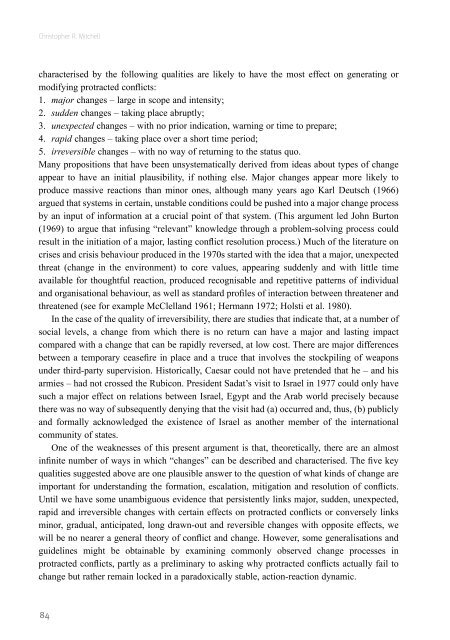Conflict, Change and Conflict Resolution - Berghof Handbook for ...
Conflict, Change and Conflict Resolution - Berghof Handbook for ...
Conflict, Change and Conflict Resolution - Berghof Handbook for ...
Create successful ePaper yourself
Turn your PDF publications into a flip-book with our unique Google optimized e-Paper software.
Christopher R. Mitchell<br />
characterised by the following qualities are likely to have the most effect on generating or<br />
modifying protracted conflicts:<br />
1. major changes – large in scope <strong>and</strong> intensity;<br />
2. sudden changes – taking place abruptly;<br />
3. unexpected changes – with no prior indication, warning or time to prepare;<br />
4. rapid changes – taking place over a short time period;<br />
5. irreversible changes – with no way of returning to the status quo.<br />
Many propositions that have been unsystematically derived from ideas about types of change<br />
appear to have an initial plausibility, if nothing else. Major changes appear more likely to<br />
produce massive reactions than minor ones, although many years ago Karl Deutsch (1966)<br />
argued that systems in certain, unstable conditions could be pushed into a major change process<br />
by an input of in<strong>for</strong>mation at a crucial point of that system. (This argument led John Burton<br />
(1969) to argue that infusing “relevant” knowledge through a problem-solving process could<br />
result in the initiation of a major, lasting conflict resolution process.) Much of the literature on<br />
crises <strong>and</strong> crisis behaviour produced in the 1970s started with the idea that a major, unexpected<br />
threat (change in the environment) to core values, appearing suddenly <strong>and</strong> with little time<br />
available <strong>for</strong> thoughtful reaction, produced recognisable <strong>and</strong> repetitive patterns of individual<br />
<strong>and</strong> organisational behaviour, as well as st<strong>and</strong>ard profiles of interaction between threatener <strong>and</strong><br />
threatened (see <strong>for</strong> example McClell<strong>and</strong> 1961; Hermann 1972; Holsti et al. 1980).<br />
In the case of the quality of irreversibility, there are studies that indicate that, at a number of<br />
social levels, a change from which there is no return can have a major <strong>and</strong> lasting impact<br />
compared with a change that can be rapidly reversed, at low cost. There are major differences<br />
between a temporary ceasefire in place <strong>and</strong> a truce that involves the stockpiling of weapons<br />
under third-party supervision. Historically, Caesar could not have pretended that he – <strong>and</strong> his<br />
armies – had not crossed the Rubicon. President Sadat’s visit to Israel in 1977 could only have<br />
such a major effect on relations between Israel, Egypt <strong>and</strong> the Arab world precisely because<br />
there was no way of subsequently denying that the visit had (a) occurred <strong>and</strong>, thus, (b) publicly<br />
<strong>and</strong> <strong>for</strong>mally acknowledged the existence of Israel as another member of the international<br />
community of states.<br />
One of the weaknesses of this present argument is that, theoretically, there are an almost<br />
infinite number of ways in which “changes” can be described <strong>and</strong> characterised. The five key<br />
qualities suggested above are one plausible answer to the question of what kinds of change are<br />
important <strong>for</strong> underst<strong>and</strong>ing the <strong>for</strong>mation, escalation, mitigation <strong>and</strong> resolution of conflicts.<br />
Until we have some unambiguous evidence that persistently links major, sudden, unexpected,<br />
rapid <strong>and</strong> irreversible changes with certain effects on protracted conflicts or conversely links<br />
minor, gradual, anticipated, long drawn-out <strong>and</strong> reversible changes with opposite effects, we<br />
will be no nearer a general theory of conflict <strong>and</strong> change. However, some generalisations <strong>and</strong><br />
guidelines might be obtainable by examining commonly observed change processes in<br />
protracted conflicts, partly as a preliminary to asking why protracted conflicts actually fail to<br />
change but rather remain locked in a paradoxically stable, action-reaction dynamic.<br />
84
















